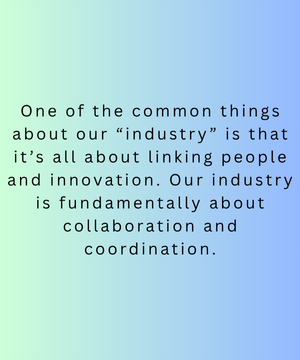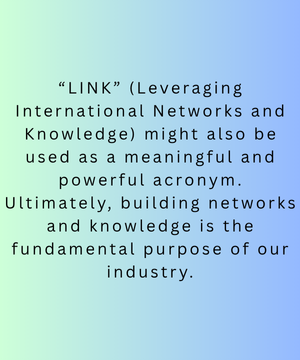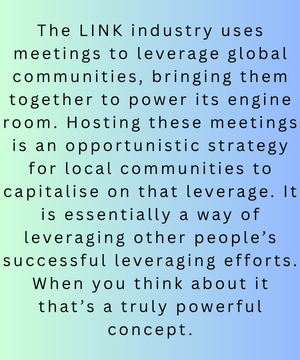- Ours is an astonishingly important industry that is made up of a large mix of stakeholders who can’t agree on what it should be called. The fact that we have no clear brand, no simple common reference for what our industry is, what it does and why it’s important makes us very weak.
- We need an easily communicated way for governments to understand that building the strength of their city, state or nation in our industry is key to their global trade and intellectual engagement.
- If we had a meaningful name for our industry it would need to be compelling and easy to remember. It would also need to be embraced as relatable by all of the industry’s moving parts – civil society, government, academia, corporations and the meetings industry.

Over the years it has been common to hear association leaders, meeting planners and people from convention bureaus, venues and PCOs say that collectively we were not an industry, we were all part of an ecosystem. In my view that’s true, and it’s a major weakness. After all, if we can’t even define ourselves as a coherent industry we also lack cohesion. This all makes it much more difficult to communicate what we do and why it’s important.
An Industry by many names has no name
The challenge in defining our industry was always that there were so many disparate moving parts, different types of organisations with widely ranging priorities, motivations and perspectives. We really weren’t the “meetings industry” because that mostly referred to the supply side. Corporations and associations had meetings but meetings defined one of their activities not their fundamental purpose. In reality, they were global customers to meetings industries which were essentially local.
So were we the “Convention industry?” Well, what about corporate meetings, conferences and exhibitions? The “MICE industry” was always at best a supply side concept, associations and corporations weren’t part of it, they were users of it, and it was always mostly about tourism.
For a long time many have been referring to the “Business events industry.” I have a historical perspective on the origins of that because I was chairing a meeting in Sydney over 20 years ago where we decided our industry should be referred to by that name and thus was born the Business Events Council of Australia (BECA) which is now part of the Australian Business Events Association (ABEA.) But in retrospect, that expression too is problematic. All types of gatherings can be called events, but not all events are business related unless, again, you are looking at it from a supplier’s perspective.
What is the value proposition?
So, yes, in the past the question over how to refer to our industry has been more driven by people from the supply side. Destination promoters and suppliers have always sought to define and communicate the “industry” and its value proposition in hopes of achieving the government support they needed at the local level to be successful. Traditionally that value proposition was about attracting people to the destination who left money behind, essentially linking the benefit to tourism. That too was a weak position for a couple of reasons. First, in many places tourism was not a star player in the local economy. Second, even if it were a star player, tourism was a piece of a much bigger pie, so ultimately meetings were a small piece of a piece of a pie. In the end, using that logic, meetings were only important because they had a relatively modest incremental impact on tourism.

Over the past couple of decades a movement has formed to better define the true value of meetings and events. The concepts of “beyond tourism impacts“ and “legacies” took hold as a way to frame the broader value of the “industry.” The Iceberg was established as a communication platform to build understanding and support for the industry by communicating a broader and more meaningful value proposition. Inevitably the message is a complicated one. Meetings and events can be transformative for all kinds of communities – professional, local, regional and national. The transformation can be economic, social and environmental. That it is not just about meetings per se, but also about knowledge exchange, building global networks, advancing science and medicine and, well actually every field of endeavour under the sun.
Nobody knows what to think about us, but they are definitely thinking about IT
So, while we may be able to frame the messaging in a way that communicates all of that clearly and concisely, there is still no consensus on how we even refer to our industry. Ours is an astonishingly important industry that is made up of a large mix of stakeholders who can’t agree on what it should be called. If we don’t know what to call our own industry, how could we possibly expect people who aren’t in our industry to understand what it’s all about or how important it is?
I always think of high tech as a good example of how an industry can effectively be framed. People around the world understand that technology has an effect on their daily lives. That industry has an acronym everyone knows, “IT.” Governments in all parts of the globe are focused on building their IT industry.

Like IT, we want governments to focus on our industry as a means to achieve their goals. Since our industry can have a positive impact on the work of any government ministry, we want all Ministers to take an interest. We want them to understand that building the strength of their city, state or nation in our industry is key to their global trade and intellectual engagement. We need them to understand that our industry is an essential part of the achievement of their future visions. In fact, our industry can even help them build their IT industry among many others! But then we say we’re the meetings industry and they understandably just want us to go talk to their Tourism Minister.
If we had a meaningful name for our industry it would need to be relevant for all of the moving parts, it would need to be compelling and easy to remember and understand. It would need to be something governments at all levels could relate to and hopefully include in their policy statements. Ideally it would be something that trips off the tongue. But before suggesting a possible solution, I need to introduce a concept that is very relevant to both governments and our industry and to this question.
The Quadruple Helix
An AI search will tell you all about the quadruple helix. In short, it’s a model relating to economics, public policy and innovation. The quadruple helix is an extension of the triple helix model which is based on the theory that collaboration between government, academia, and industry is the most efficient way to drive innovation. The quadruple helix introduces civil society, including professional and trade associations, as a fourth critical element. This recognises that innovation also requires a response to societal needs, values and real-world challenges. Government provides the policy and investment, corporations provide business know how, strategic acumen and investment, universities provide research, analysis and theoretical frameworks and associations provide international networks, perspectives, expertise, applied knowledge and insights on global best practices. The quadruple helix is a match made in heaven. It actually defines what our industry is all about and is aligned with the modern thinking of progressive governments.
Could we be the LINK industry?
“Link” is an interesting word. It can be a noun, as in a link or nexus between people or things. It can be a verb, meaning to connect things. The Quadruple Helix is a model that seeks to link the four key engines of innovation. Our industry is all about connections at every level.
One of the common things about our “industry” is that it’s all about linking people and innovation. Our industry is fundamentally about collaboration and coordination. Associations seek to link their members in terms of knowledge and networks. Corporations seek to link to the innovation and markets that associations and exhibitions provide. Academia is seeking research links and links to other parts of the helix as a path to scholarly innovation and grants. Governments pursue policies that are strengthened by their links to the helix – and our industry can connect their local helix to global ones. Destination promoters seek to link their hospitality suppliers and event planners together. By doing so, these events also provide links for local civil society, academia, corporations and government to access global knowledge and networks for building local capacities, trade and achieving social progress.

Leveraging International Networks and Knowledge (LINK)
“LINK” might also be used as a meaningful and powerful acronym. Ultimately, building networks and knowledge is the fundamental purpose of our industry. Leveraging those networks and that knowledge is where meetings and events come in.
Certainly, innovation is possible in a closed system. But, history has proven that collaboration across borders is a powerful accelerant to innovation. Yes, people can create things in their own labs. But, likely many of the tools, methods, background knowledge and theories that enabled them to discover or invent new things came from outside their own labs.
Doctors and scientists have been leveraging knowledge, insights and revelations from the scientific community before any of them even went to university. They continue their leveraging throughout their careers through collaborative efforts and participation in societies. Leveraging communities of interest and corporate sponsorship is the lifeblood of associations. Their members in turn leverage the associations for knowledge and networks. Corporations may be charitable, but in most instances are sponsoring association activities because they can leverage them commercially. Universities and R&D facilities are leveraging meetings to develop research links or to connect to funders.
Governments increasingly are understanding that hosting meetings and events is a powerful and high-value strategy for building global trade and intellectual engagement. Leveraging a global helix instead of just operating in a local one offers pathways to new talent, investment, sector development, exports, social and environmental policy improvements, improved health and public welfare, and the list goes on.
Yes, there are other means of leveraging global networks and accessing global knowledge, but few would disagree with the premise that actually getting people together is the most powerful way to do that. But meetings are not the industry. Meetings are a platform, albeit the most efficient one utilised by the LINK industry.
The LINK industry uses meetings to leverage global communities, bringing them together to power its engine room. Hosting these meetings is an opportunistic strategy for local communities to capitalise on that leverage. It is essentially a way of leveraging other people’s successful leveraging efforts. When you think about it that’s a truly powerful concept.
This is where the destination promoters come in. Convention bureaus and their industry partners, the venues, PCOs, hotels and service providers are the supply chain partners that enable a local stake in the LINK industry. They are the conduit through which local and global LINK industries connect and are essential to the growth and success of the LINK industry.
So, when you think about it, every player in our industry is linking and leveraging and it’s fundamentally driven by international networks and knowledge.
Consider joining the movement
The Iceberg is currently transitioning from being primarily a communications platform to becoming a support mechanism for building a global movement that has “one message, many voices.” Developing a simple, compelling and memorable way to refer to our industry would simplify that challenge enormously. That could be the “LINK industry” or something similar. Either way, if you feel that promoting our industry locally and globally is important, keep an eye out for news from The Iceberg and consider taking an active role.
